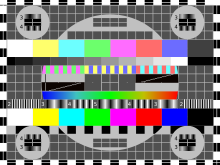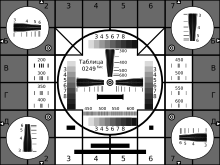Universal Electronic Test Chart
UEIT - Universal Electronic Test Chart (russian: УЭИТ - Универсальная электронная испытательная таблица) is a Soviet/Russian test card, designed to test TVs operating in the analogue SECAM colour standard.[1][2][3]



UEIT was developed by N. G. Deryugin and V. A. Minaev at the NII Radio Scientific Research Institute as the successor to the monochrome ТИТ-0249 test card[4] with the informal name of "Colour Prevention Table" (TCP).[5][6][7] This was the second attempt by the Soviets to create a colour test card, since previous efforts undertaken in 1954 (the ТИТ-0154 test card)[8] in conjunction with the early prototype NIIR/SECAM IV colour television system, were abandoned in favour of regular SECAM III B. On the golden jubilee year of the October Revolution in 1967, colour broadcasts debuted in both Moscow and Leningrad (now Saint Petersburg).
Experimental broadcasts using the first three prototype versions of the UEIT (one of which was a modification of the Hungarian HTV TR.0782 test card;[9] but all were collectively referred to as UEIT-1) began from the Ostankino Tower transmitter in 1970, with results being used to create the current version of the test pattern. This new version, called UEIT-2, was introduced in 1971 with several GOST-approved modifications up to 1986, and was used on terrestrial broadcast and on point-to-point links throughout the Soviet Union.[10]
The prototypes and current version of the UEIT were used on Soviet television services: six national channels ("First Programme", All Union Programme, Moscow Programme, Fourth Programme, Fifth Programme and the Sixth Programme) and Third Programme/regional stations.[11] It was also used in some Soviet Republics and allied countries like the Estonian SSR,[12] Latvian SSR,[13] Lithuanian SSR,[14] Kirghiz SSR, Byelorussian SSR, Ukrainian SSR,[15] Kazakh SSR, Tajik SSR and the Georgian SSR, as well as Cuba. It continued to be used on post-Soviet times in Russia and some former Soviet republics and allies.[16][17][18][19]
The card was replaced by digital versions with the switch to digital broadcasting in Russia using the DVB-T2 standard by late-2019.[20][21]
Usage and features
editThis section needs additional citations for verification. (July 2023) |
The UEIT allowed to adjust image geometry and picture settings such as brightness, contrast and colour saturation. Other more technical adjustments were also possible, such as cathode-ray tube focus and raster distortions.
The card features the following elements:
- Grid box - makes up the background of the table. Allows adjustment of CRT convergence and easy reference for test card elements by "line" numbers (as indicated below);
- Small circles - at lines 3, 4, 17, 18, they have the same function as the Gratings;
- Center crosshair - in the center of the large circle, allows further convergence and image centering adjustments on CRTs;
- Table border - fiducial marks for setting proper image geometry and overscan;
- Circles - provide a way to correct vertical and horizontal raster scan distortions;
- Colour bars - two sets of bars (75% saturation at lines 6 to 7; 100% saturation at lines 14 to 15) to adjust colour saturation;
- Greyscale - a set of bars on line 8, that allow setting brightness, contrast, white balance and black level;
- Contrasting colour stripes - located at line 9, they allow checking of colour transitions;
- Slanted stripes- located at lines 10 to 11, they allow checking of interlace accuracy ;
- Smooth colour transition - at line 12, it allows to check the color linearity over the full colour spectrum, or a green to magenta transition;
- Gratings - located at line 13, these help to assess resolution and image focus. They are formed by bursts of sinusoidal signals with frequencies of 2, 3, 4 and 5 MHz, corresponding to resolutions of 220, 330, 440 and 550 horizontal TV lines;[22]
- Black and white squares- alternating squares at line 16, to evaluate the frequency response of the video chain;
See also
editReferences
edit- ^ "TV USSR Opening in 1980s". 27 April 2010 – via www.youtube.com.
- ^ "TV-DX / R1-TSS-Leningrad--UEIT testcard". 7 March 2010 – via www.youtube.com.
- ^ "Телевизоры "Весна-346", "Весна-346Д" - 6. ПОДГОТОВКА К РАБОТЕ И ПОРЯДОК РАБОТЫ С ТЕЛЕВИЗОРОМ". VintageTorg.com: Документы. Retrieved 2023-02-26.
- ^ "Вы точно человек?" (PDF). cyberleninka.ru.
- ^ Дерюгин Н. Г., Минаев В. А., Универсальная электрическая испытательная таблица, Техника кино и телевидения, 1970, № 10.
- ^ Дерюгин Н. Г., Минаев В. А. Новая универсальная электрическая испытательная таблица [для контроля телевизионных изображений]. — Электросвязь, 1972, № 2, с. 1—5.
- ^ Латыпова, С. М.; Безруков, В. Н. (February 8, 2015). "Обзор Испытательных Таблиц И Сигналов Для Систем Вещательнго Телевидения". Фундаментальные Проблемы Радиоэлектронного Приборостроения. 15 (5) – via eLibrary.ru.
- ^ "Настроечные таблицы - Старый Телевизор".
- ^ "Podani György".
- ^ "Vestnik svi︠a︡zi". Radio i svi︠a︡zʹ. February 7, 1975 – via Google Books.
- ^ "TV-DX CT1 HNG R58 01.10.1988". 17 March 2017 – via www.youtube.com.
- ^ "TV-DX / R2-Eesti-UEIT testcard". 8 March 2010 – via www.youtube.com.
- ^ "Latvia TV test card 1991 УИЭТ SECAM". 13 June 2009 – via www.youtube.com.
- ^ "Lietuvos nacionalinis radijas ir televizija LRT UEIT 0167 test card via Es 1988". 14 August 2012 – via flickr.com.
- ^ "Rijn Muntjewerff". ing-sat.hu. Retrieved 2023-01-12.
- ^ Holland, John Märsylä, Delfzijl (May 31, 2010). "John Märsylä's DX-Blog: USSR UEIT Test Card still exist".
{{cite web}}: CS1 maint: multiple names: authors list (link) - ^ "TV-DX KTR Kyrgyzstan, opening with clock 01.07.2002". 16 July 2020 – via www.youtube.com.
- ^ "Test card Georgia TV. SECAM 1998". 20 June 2009 – via www.youtube.com.
- ^ "Cuba TV as received in north Louisiana". tvdxexpo.com. Retrieved 2023-04-02.
- ^ "Russia postpones digital switchover in 21 regions". Digital TV Europe. 2019-04-29. Retrieved 2021-09-28.
- ^ "Началась последняя волна отключения аналогового вещания в РФ". Interfax.ru (in Russian). Retrieved 2021-09-28.
- ^ "6. ПОДГОТОВКА К РАБОТЕ И ПОРЯДОК РАБОТЫ С ТЕЛЕВИЗОРОМ".